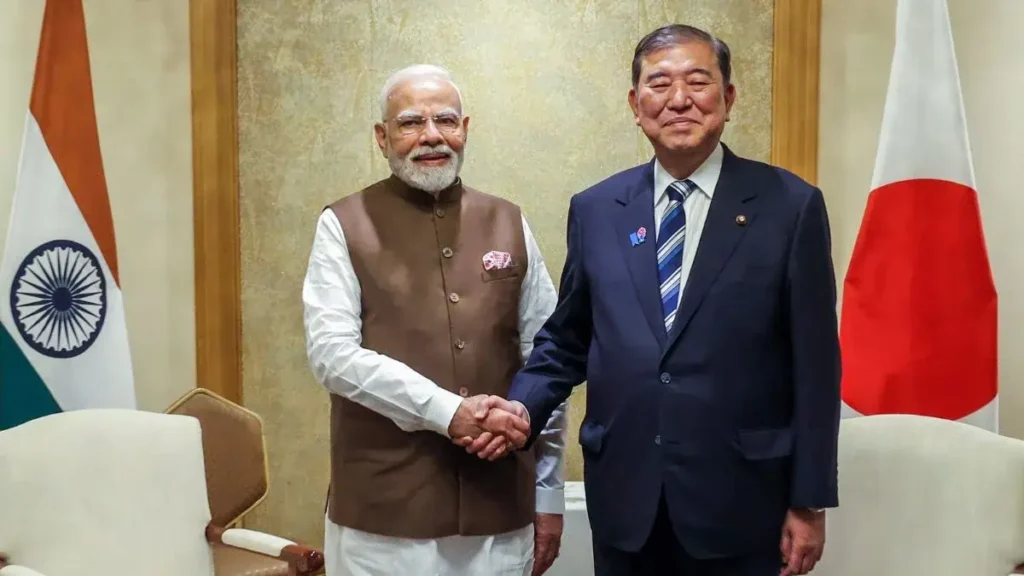New Delhi : In a landmark diplomatic engagement, Indian Prime Minister Narendra Modi visited Tokyo on August 29-30, 2025, at the invitation of Japanese Prime Minister Ishiba Shigeru for the 15th India-Japan Annual Summit. The two leaders sealed multiple pacts and unveiled a comprehensive “India-Japan Joint Vision for the Next Decade,” outlining eight strategic directions to elevate their Special Strategic and Global Partnership. This summit, held amid shifting geopolitical dynamics in the Indo-Pacific, emphasized economic growth, security resilience, technological innovation, and people-to-people exchanges, setting an ambitious target of 10 trillion yen in Japanese private investment into India over the next decade.
The visit began with Modi receiving a ceremonial Guard of Honour at the Prime Minister’s Office in Tokyo, symbolizing the deep-rooted friendship between the two nations. Rooted in civilizational ties, shared democratic values, and mutual respect, the partnership has expanded over the past decade into defense, trade, investment, science, technology, skills, mobility, cultural links, and more. With over 70 dialogue mechanisms across sectors, the leaders reviewed progress since the relationship was elevated to Special Strategic and Global Partnership in 2014 and committed to advancing it for future generations.

Key Outcomes: A Roadmap for Transformative Cooperation
Central to the summit was the adoption of three pivotal documents:
India-Japan Joint Vision for the Next Decade: Eight Directions to Steer the Partnership
- This 10-year framework, posted by PIB Delhi on August 29, 2025, builds on the nations’ complementary strengths—India’s talent and markets alongside Japan’s technology and capital—to foster a free, open, peaceful, and prosperous Indo-Pacific based on the rule of law. The eight pillars include:
- (I) Next Generation Economic Partnership: Aiming to harness economic synergies as the world’s fourth and fifth largest economies. Building on the 2022-2026 target of 5 trillion yen in public and private investment (already progressing well), a new goal of 10 trillion yen in private investment was set. Efforts include accelerating reviews of the India-Japan Comprehensive Economic Partnership Agreement (CEPA), strengthening industrial ties via the India-Japan Industrial Competitiveness Partnership (IJICP) for “Make in India,” promoting Japanese firms in GIFT City, enhancing SME collaboration through an India-Japan SME Forum, fostering agri-business via model farms and culinary training, and advancing ICT opportunities. The vision extends to the Global South, launching the India-Japan Cooperation Initiative for Sustainable Economic Development in Africa, aligning with India’s MAHASAGAR vision and Japan’s Economic Region Initiative of Indian Ocean-Africa to position India as a hub for South Asia and Africa.
- (II) Next Generation Economic Security Partnership: Launching the India-Japan Economic Security Initiative to bolster supply chains in semiconductors, critical minerals, pharmaceuticals, biotechnology, telecommunications, clean energy, and emerging technologies. This involves concrete projects via the Dialogue on Economic Security (including Strategic Trade and Technology), policy sharing, mechanisms like the Memorandum of Cooperation on Mineral Resources and India-Japan Digital Partnership 2.0, private-sector actions via JETRO-CII-JCCII Joint Action Plan, a new business pillar for dialogue, the Japan-India AI Cooperation Initiative (JAI) for trusted AI ecosystems, and battery supply chain cooperation.
- (III) Next Generation Mobility: Establishing the Next Generation Mobility Partnership (NGMP) for infrastructure and logistics, leveraging Japanese tech and Indian talent. Focus areas include high-speed rail (advancing “Make in India” rolling stock, signaling, AI maintenance, and energy transition), metro systems, transit-oriented development, Mobility-as-a-Service, smart cities for decarbonization, data-driven connected technologies, automobile/aircraft/shipping manufacturing with sustainable fuels, cold-chain logistics, and 3D urban modeling for disaster resilience. Emphasis on exporting Indian-made products globally, capacity building, and mainstreaming disaster risk reduction under the Sendai Framework.
- (IV) Next Generation Ecological Legacies: Promoting SDGs and net-zero goals via Mission LiFE, diverse energy transition pathways, strengthened India-Japan Clean Energy Partnership, circular economy initiatives (waste-to-energy, recycling), sustainable farming, marine/coastal protection, agroforestry, bamboo utilization, Joint Crediting Mechanism (JCM), ICEMAN initiative, green hydrogen, satellite tech for emissions, and multilateral efforts like LeadIT.
- (V) Next Gen Technology and Innovation Partnership: Tapping scientific capabilities through collaborations like Indian Beamline at KEK Tsukuba (extended), quantum tech, high-performance computing, startup linkages via Japan-India Startup Support Initiative (JISSI), “India-Japan fund of funds” for AI startups, ICT Joint Working Group, space ties including Lunar Polar Exploration (LUPEX) Mission and private linkages, fission/fusion research (ITER, small modular reactors), and joint food/agricultural sciences aligned with G20 declarations and AI-ENGAGE.
- (VI) Investing in Next Gen Health: Aiming for universal health coverage (UHC) by linking Ayushman Bharat and Japan’s Asia Health and Wellbeing Initiative, regular Joint Committee Meetings, research in geriatric medicine, stem cells, regenerative/gene therapy, synthetic biology, cancer, digital health, UHC Knowledge Hub collaboration, medical professional exchanges/fellowships, critical medicine supply chains, and centers of excellence in Japan for yoga, meditation, Ayurveda, and holistic wellness supported by India’s Ministry of AYUSH.
- (VII) Next Gen People-to-People Partnership: Launching an Action Plan for India-Japan Human Resource Exchange targeting 500,000 exchanges (including 50,000 skilled Indians to Japan) over five years. Initiatives include expanding vocational training via INPACT (building on JIM and JEC), employment events/internships/surveys under India-Japan Talent Bridge (IJTB) by METI, researcher/student exchanges (Sakura Science, LOTUS, HOPE, EDU-Port Japan), organizational ties via e-Migrate and Global Capability Centers, tourism/heritage promotion, Japanese language teacher training/curricula, and dispatching “NIHONGO Partners” assistants.
- (VIII) Next-Gen State-Prefecture Partnership: Promoting subnational ties with new sister-city/state-prefecture partnerships, direct flights, SME/business forums (e.g., India-Kansai, exploring India-Kyushu), information/best practice sharing, and three annual delegation visits each, led by foreign ministries.
- Joint Declaration on Security Cooperation: This elevates defense ties amid regional realities, promoting interoperability, maritime security, naval/coast guard cooperation for a peaceful Indo-Pacific, technological/industrial collaboration for resilience in critical sectors, addressing traditional/non-traditional threats (including new tech challenges), common global objectives via multilateral groups, and reinforcing 2+2 Ministerial meetings and security dialogues.
- Action Plan for India-Japan Human Resource Exchange and Cooperation: A roadmap for 500,000 two-way exchanges in five years, focusing on 50,000 skilled personnel from India to Japan, building on programs like JIM, JEC, Sakura Science, and new initiatives for training, internships, and mobility.
MoUs and Agreements: From Minerals to Space
Several MoUs were signed, witnessed by Modi and Ishiba:
- Joint Crediting Mechanism: To promote decarbonizing technologies, Japanese investment, and India’s sustainable development.
- India-Japan Digital Partnership 2.0: For digital public infrastructure, talent nurturing, joint R&D in AI, IoT, semiconductors.
- Decentralised Domestic Waste Water Management: Promoting wastewater reuse and sustainable sewage treatment.
- Foreign Service Training: Between Sushma Swaraj Institute and Japan’s Ministry of Foreign Affairs for diplomatic exchanges.
- Mineral Resources: Enhancing supply chains, joint investments in exploration/mining/processing, deep-sea mining, stockpiling, and third-country projects.
- Cultural Exchange: Deepening institutional ties, researcher/scientist/startup/industry collaborations.
- ISRO-JAXA Arrangement for Joint Lunar Polar Mission (LUPEX/Chandrayaan 5): Laying groundwork for collaborative space exploration.
- Joint Declaration of Intent on Clean Hydrogen and Ammonia: Advancing research, investment, deployment for clean energy.
Additional launches included the India-Japan AI Initiative for LLMs, training, and trusted AI; Next-Generation Mobility Partnership for G2G/B2B in infrastructure; India-Japan SMEs Forum; Sustainable Fuel Initiative for biogas/biofuels; and subnational exchanges with three reciprocal visits annually, plus forums for Kansai and Kyushu regions.
Economic and Development Focus
Leaders welcomed progress toward the 5 trillion yen investment target since 2022 and set 10 trillion yen for private investment, urging regulatory reforms for ease of doing business. Japan recognized India’s potential for supply chain deepening, while Modi invited more Japanese firms. Cooperation extends to JITs, logistics, textiles, food processing, agriculture, automotives, capital goods, MSMEs under IJICP, and diversifying trade via CEPA review.
Development aid highlights India’s North Eastern Region via Act East Forum for connectivity. The Mumbai-Ahmedabad High-Speed Rail flagship project advances with Shinkansen tech introduction by early 2030s, including E10 series, Japanese signaling, GIT, and E5 rolling stock.
Energy cooperation under Clean Energy Partnership includes JCM, clean hydrogen/ammonia for net-zero pathways reflecting national circumstances.
People-to-people ties celebrate 2025 as India-Japan Year of Science, Technology, and Innovation (40th anniversary of first S&T MoU), with joint research, internships via LOTUS/Sakura, LUPEX progress, Indian Beamline extension, and 11th S&T Joint Committee on quantum, clean tech, disaster management, biotech, geospatial.
Regional linkages feature new state-prefecture partnerships (e.g., Andhra Pradesh-Toyama, Tamil Nadu-Ehime, Uttar Pradesh-Yamanashi, Gujarat-Shizuoka), Kansai Coordination, Expo 2025 Osaka participation, and GREEN x EXPO 2027 Yokohama.
Global and Regional Stance
The Joint Statement on “Partnership for Security and Prosperity of our Next Generation” (August 29, 2025) reaffirms commitment to a rules-based international order and free Indo-Pacific. Leaders condemned terrorism, urging justice for organizers/financiers and actions against UN-listed groups like Al Qaeda, ISIS, LeT, JeM. They supported FOIP-IPOI synergy, ASEAN centrality/AOIP.
Concerns include Myanmar’s crisis (cease violence, democracy return, Five-Point Consensus); East/South China Seas (oppose unilateral actions, militarization, uphold UNCLOS); North Korea’s missiles/nuclear pursuits (denuclearization per UNSCRs); Ukraine (just peace per UN Charter); Middle East (restraint, ceasefire in Gaza/Israel-Iran, hostage release, humanitarian aid).
They pushed UNSC reform with text-based negotiations for permanent/non-permanent expansion, mutual support for seats, and broader UN efficiency.
Africa collaboration launches Japan-India Initiative for Sustainable Development, post-TICAD9, aligning with Economic Region Initiative of Indian Ocean-Africa.
Significance and Future Outlook
This summit, Modi’s first to Japan since May 2023, positions the partnership for the 75th diplomatic anniversary in 2027. Modi thanked Ishiba for hospitality and invited him to India’s Quad Summit later in 2025, which Ishiba accepted. As Modi heads to Tianjin for the SCO Summit, the outcomes—spanning JPY 10 trillion investment, AI/clean energy initiatives, security elevation, and 500,000 exchanges—promise tangible benefits, reinforcing India-Japan as pillars of Indo-Pacific stability and global innovation.
Frequently Asked Questions
1. What is the India-Japan Joint Vision for the Next Decade?
The India-Japan Joint Vision for the Next Decade is a 10-year strategic framework adopted during the 15th India-Japan Annual Summit on August 29-30, 2025, in Tokyo. It outlines eight directions to steer the Special Strategic and Global Partnership, focusing on areas such as economic partnership, economic security, mobility, ecological legacies, technology and innovation, health, people-to-people ties, and state-prefecture partnerships. This vision aims to leverage complementary strengths—India’s talent and markets with Japan’s technology and capital—to promote a free, open, peaceful, and prosperous Indo-Pacific based on the rule of law, while fostering mutual growth and closer ties between the peoples of both nations for future generations.
2. What are the key outcomes of the 15th India-Japan Annual Summit?
The summit resulted in several key outcomes, including the adoption of the Joint Vision for the Next Decade, a Joint Declaration on Security Cooperation to enhance defense ties, and an Action Plan for India-Japan Human Resource Exchange targeting 500,000 two-way personnel exchanges over five years (including 50,000 skilled Indians to Japan). Other highlights include launching the India-Japan Economic Security Initiative, setting a 10 trillion yen private investment target from Japan to India, signing MoUs on mineral resources, digital partnership 2.0, joint crediting mechanism, clean hydrogen and ammonia, cultural exchange, domestic wastewater management, and space cooperation for the Lunar Polar Exploration Mission. The leaders also emphasized progress in high-speed rail, AI initiatives, and subnational partnerships.
3. What is the new investment target set by Japan in India, and how does it build on previous goals?
Japan has set a new target of 10 trillion yen in private investment in India over the next decade, building on the progress of the previous 2022-2026 target of 5 trillion yen in public and private investment and financing, which is already advancing well. This ambition aims to enhance bilateral trade and investment through reviews of the Comprehensive Economic Partnership Agreement (CEPA), industrial cooperation under the India-Japan Industrial Competitiveness Partnership (IJICP) for “Make in India,” promotion of Japanese firms in GIFT City, SME collaborations via a new India-Japan SME Forum, agri-business exchanges, and ICT opportunities. It also extends to third-country cooperation, such as the India-Japan Cooperation Initiative for Sustainable Economic Development in Africa.
4. How does the summit address economic security and technology cooperation between India and Japan?
Japan has set a new target of 10 trillion yen in private investment in India over the next decade, building on the progress of the previous 2022-2026 target of 5 trillion yen in public and private investment and financing, which is already advancing well. This ambition aims to enhance bilateral trade and investment through reviews of the Comprehensive Economic Partnership Agreement (CEPA), industrial cooperation under the India-Japan Industrial Competitiveness Partnership (IJICP) for “Make in India,” promotion of Japanese firms in GIFT City, SME collaborations via a new India-Japan SME Forum, agri-business exchanges, and ICT opportunities. It also extends to third-country cooperation, such as the India-Japan Cooperation Initiative for Sustainable Economic Development in Africa.
5. What is the significance of India-Japan relations as highlighted in the summit?
India-Japan relations are significant due to converging strategic interests in countering China’s interventions in the Indo-Pacific, including the South China Sea. Key aspects include defense ties via the Acquisition and Cross-Servicing Agreement (ACSA) and exercises like Dharma Guardian, Shinyuu Maitri, and JIMEX; reformed multilateralism through UNSC reforms, Quad, G20, and G4; industrial development via IJICP and SME forums; and broader cooperation in clean energy, health (linking Ayushman Bharat and Asia Health Initiative), mobility (Next Generation Mobility Partnership), and people-to-people exchanges. The partnership promotes regional stability, economic prosperity, sustainable development, and a rules-based order, with tangible benefits like enhanced supply chain resilience, innovation, and cultural ties for future generations.

